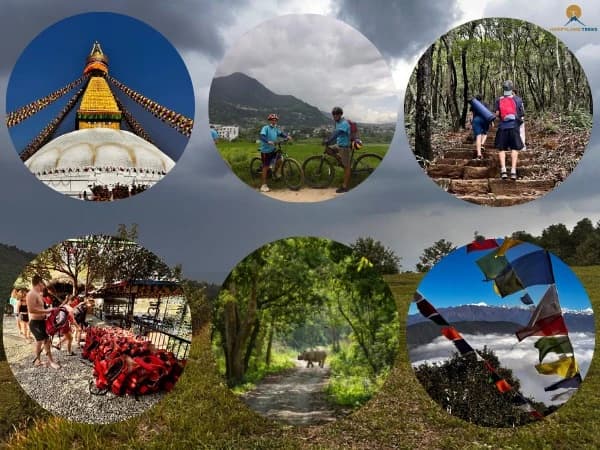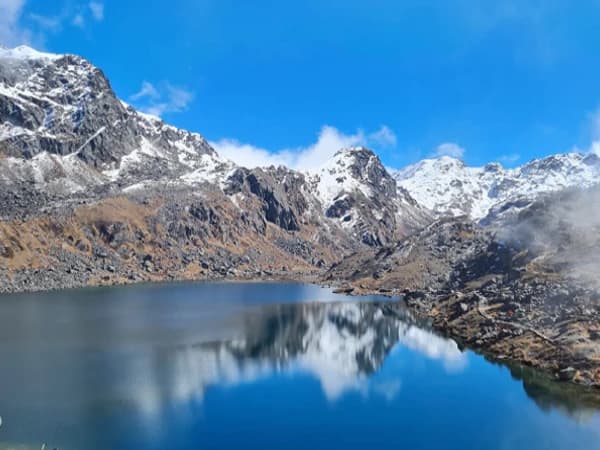Everest Base Camp Elevation
Everest Base Camp sits at an impressive 5,364 meters (17,598 feet) above sea level. This is where most trekkers reach after a challenging but rewarding journey through Nepal’s Khumbu region. The altitude is significant, and many trekkers experience symptoms of altitude sickness as they make their way up.
While reaching Everest Base Camp Elevation is the main goal, the trek itself spans approximately 12-14 days, with daily elevation gains that can affect your body. Along the way, you’ll pass through Sherpa villages, lush forests, rugged terrain, and face spectacular mountain views. This trek truly offers a mix of natural beauty, cultural experiences, and physical challenge. So, this trek to Everest Base Camp is not just about reaching a destination
How Does the Elevation Affect Your Trek?
The higher you go, the thinner the air becomes, which means there is less oxygen. Your body has to work harder to get the oxygen it needs. While this adds to the difficulty of the trek, it also gives trekkers a sense of accomplishment. Here’s a general breakdown of the altitude levels along the trek:
1. Lukla (2,860 meters / 9,383 feet):
Most trekkers begin their journey here. Lukla is a bustling mountain town and a gateway to the Everest region. You’ll already be starting at a high elevation, and it’s a good idea to spend the first night in Lukla to get your body used to the altitude.
2. Namche Bazaar (3,440 meters / 11,286 feet):
This bustling Sherpa town is often referred to as the "gateway to Everest." Namche Bazaar offers not only a place for acclimatization but also the first real glimpse of Mount Everest. By this point, the effects of the altitude will become noticeable. Don’t rush!!! just taking breaks and drinking plenty of water will be crucial as you adjust.
3. Tengboche (3,867 meters / 12,687 feet):
Tengboche is home to the famous Tengboche Monastery and provides breathtaking views of Mount Everest, Lhotse, and Ama Dablam. As you climb higher, you’ll start to feel the effects of the altitude, which is why acclimatization days are essential.
4. Pheriche (4,371 meters / 14,340 feet):
Pheriche offers an opportunity to rest, enjoy the surrounding scenery, and focus on acclimatization. The air is thinner at this point, and it’s normal for trekkers to experience breathlessness and fatigue. It’s essential to take it slow to avoid overexerting yourself.
5. Everest Base Camp (5,364 meters / 17,598 feet):
Finally, you’ll reach Everest Base Camp Elevation, your final destination. Standing at 5,364 meters (17,598 feet), you’ll be above 5,000 meters, where the body can really feel the effects of the altitude. Imagine, your achievement is monumental, remember to take it slow and listen to your body when you’re at this height.
How to Handle Altitude on the Everest Base Camp Trek
Here are a few tips to handle the elevation during your trek:
- Climb Slowly, Acclimatize Well: Climbing slowly is key to adjusting your body to the altitude. The general rule of thumb is "climb high, sleep low," which means you should aim to reach higher altitudes during the day but return to a lower elevation to sleep. This gives your body time to adjust to the thinning air.
- Stay Hydrated: The dry mountain air can cause dehydration, so it’s essential to drink water frequently. Carry a water bottle with you and make sure you’re hydrating throughout the day. Herbal teas or soup can also help keep you hydrated.
- Eat Well, Fuel Your Body: Eating nutritious meals is key. On the trek, you’ll have plenty of opportunities to enjoy traditional Sherpa food, including dal bhat (lentil soup), rice, potatoes, and vegetables. Keep energy-boosting snacks like nuts, chocolate, and energy bars handy.
- Know the Symptoms of Altitude Sickness: Symptoms include headaches, nausea, dizziness, loss of appetite, and shortness of breath. Don’t ignore these symptoms. If they persist or worsen, it’s important to stop, rest, and descend to a lower altitude.
- Medication and Consultation: It’s advisable to consult your doctor before embarking on the trek. Some trekkers take Diamox (acetazolamide), which can help prevent altitude sickness, but make sure to consult your doctor for proper guidance.
Best Time to Trek to Everest Base Camp
The timing of your trek is crucial to having a safe and enjoyable experience. The best times to trek to Everest Base Camp elevation are during the spring (March to May) and autumn (September to November) seasons. Here’s why:
Spring (March - May):
- Weather: During spring, the weather is relatively mild, with clear skies and pleasant temperatures. The daytime temperatures range from 10°C to 15°C (50°F to 59°F), while the nights can get cold, ranging from -10°C to -5°C (14°F to 23°F).
- Scenic Views: The spring months offer beautiful landscapes as flowers and rhododendrons bloom, making it a particularly scenic time for trekking.
- Trek Traffic: Spring is a popular time for trekkers, so you’ll have the chance to meet fellow adventurers on the trail but also expect some busy routes.
Autumn (September - November):
- Weather: Autumn is another excellent time for trekking. The weather is generally dry, and the skies are clear, providing stunning views of the mountains. Daytime temperatures are similar to spring, around 10°C to 15°C (50°F to 59°F), with nights getting colder.
- Scenic Views: This season also offers excellent visibility, with crystal-clear views of the Himalayan peaks.
- Trek Traffic: Like spring, autumn is a popular trekking season, but you’ll find a good balance of fellow trekkers without the overcrowding found in peak seasons.
Winter (December - February):
- Weather: While winter offers solitude and quiet on the trails, temperatures can drop significantly, with freezing conditions in the higher elevations. The trekking season during winter is not recommended for beginners due to the harsh weather conditions.
Monsoon (June - August):
- Weather: The monsoon season brings heavy rainfall, which can cause muddy trails, landslides, and poor visibility. Trekking during the monsoon season is generally discouraged as it can be dangerous due to slippery paths and increased risks of altitude sickness.
Best Trekking Package for Everest Base Camp Elevation
When choosing a trekking package for Everest Base Camp elevation, it’s important to consider your budget, the level of comfort you want, and the services included. Here are a few popular trekking packages based on the time of year and trek difficulty:
- Duration: 14 days
- Included: Local guide, porter service, trekking permits, tea house accommodations, and meals.
- Best Time: Spring or Autumn for the best weather and visibility.
- Cost: $1500 - $1,523 USD
- Features: This package is ideal for trekkers who want an affordable experience. It covers the basic essentials, including a guide and porters to help with your bags.
Luxury Trekking Package:
- Duration: 14 days
- Included: Luxury lodges with private rooms, gourmet meals, experienced guides, and helicopter rides to and from the base camp (optional).
- Best Time: Spring or Autumn for favorable weather.
- Cost: $3,000 - $5,000 USD
- Features: For trekkers who prefer a more luxurious experience, this package includes everything from upgraded accommodations to private transfers. You can even opt for a helicopter ride to skip the trek and get a bird's eye view of Everest Base Camp.
Customized Trekking Package:
- Duration: Flexible (8-14 days)
- Included: Customizable itineraries based on fitness level, desired pace, and preferred accommodations.
- Best Time: Spring or Autumn
- Cost: Varies depending on customization
- Features: This package offers flexibility in planning. Whether you prefer a faster trek or a more relaxed pace, you can tailor your experience with the help of local agencies.
FAQs About Everest Base Camp Elevation
1. Is the Everest Base Camp trek dangerous due to its elevation?
While the elevation can pose risks, with proper preparation, acclimatization, and guidance from experienced trekking agencies, the trek is generally safe for most people. The key to a successful trek is taking it slow, staying hydrated, and respecting your body’s limits.
2. How can I prepare for the high Everest Base Camp elevation before the trek?
It’s a good idea to get in shape before you start the trek by focusing on improving your cardio and stamina. Walking or hiking on elevated trails (if possible) will help condition your body for the trek. You can also try spending a few days at higher altitudes before embarking on the trek.
3. What are the symptoms of altitude sickness?
Symptoms can range from mild to severe and may include dizziness, nausea, headaches, loss of appetite, and difficulty sleeping. If you experience these symptoms, it’s vital to stop and rest. Descending to a lower altitude and seeking medical attention is crucial in severe cases.
4. How long does it take to acclimatize to the elevation?
The acclimatization process usually takes 2-3 days in areas like Namche Bazaar and Pheriche. It’s important not to rush the process; your body needs time to adjust to the higher altitudes.
5. What is the highest elevation I’ll reach on the Everest Base Camp trek?
The highest point on the trek is Everest Base Camp Elevation, which sits at an altitude of 5,364 meters (17,598 feet).
6. How will the altitude affect my trekking experience?
As you climb higher, you’ll likely experience some physical discomfort such as shortness of breath and fatigue. However, the views of the snow-capped peaks, the peaceful environment, and the sense of accomplishment will make the effort worth it. Just take your time, rest when needed, and enjoy the journey.
7. Can I trek to Everest Base Camp without prior trekking experience?
While the trek to Everest Base Camp is not technically difficult, it requires good physical fitness and stamina. If you're new to trekking, it's best to train beforehand and ensure you're prepared for the altitude. Many trekkers with no previous experience have completed the trek successfully with proper preparation. So i prefer to have someone with you (Guide).
Conclusion
The Everest Base Camp Elevation is undoubtedly one of the most challenging treks in the world, but it’s also one of the most rewarding. The views, the culture, the Sherpa hospitality, and the sense of achievement when you reach base camp make it all worth it. The trek offers a unique experience for all types of trekkers whether you’re an experienced mountaineer or a beginner looking to challenge yourself.
With proper preparation, patience, and an appreciation for the beauty around you, the Everest Base Camp trek will be an unforgettable journey. Remember, the mountain doesn’t just change you physically, it will challenge your limits, and in return, offer you memories that last a lifetime.
So, if Everest Base Camp Elevation is on your bucket list,




